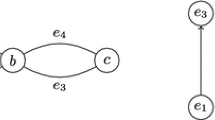Abstract
The permutahedron of a poset is the convex hull of all incidence vectors of linear extensions. For the case ofN-sparse posets in which any five elements induce at most oneN we give a characterization of the permutahedron in terms of linear inequalities. This yields an LP-solution for minimizing the weighted mean completion time for jobs with unit processing times andN-sparse precedence constraints. We close with an extension of our approach to arbitrary processing times.
Similar content being viewed by others
References
A. von Arnim, U. Faigle and R. Schrader, “The permutahedron of series-parallel posets”,Discrete Applied Mathematics 28 (1990) 3–9.
A. von Arnim and A. Schulz, “Facets of the generalized permutahedron of a poset”,Discrete Applied Mathematics 72 (1997) to appear.
E. Balas, “A linear characterization of permutation vectors”, Management Sci. Res. Report 364, Carnegie-Mellon University, Pittsburgh, PA, 1975.
P. Gaiha und S.K. Gupta, “Adjacent vertices on a permutation”, SIAMJournal on Applied Mathematics 32 (1977), 323–327.
M. Habib and R. Möhring, “On some complexity properties ofN-free posets and posets with bounded decomposition parameter”,Discrete Mathematics 63 (1987) 157–182.
B. Jamison and S. Olariu, “A tree representation forP 4-sparse graphs”,Discrete Applied Mathematics 35 (1992) 115–129.
V. Klee and G.J. Minty, “How good is the simplex algorithm”, in: O. Shisha, ed.,Inequalities III, (Academic Press, New York 1972).
E.L. Lawler, “Sequencing jobs to minimize total weighted completion time subject to precedence constraints”,Annals of Discrete Mathematics 2 (1978) 75–90.
M. Queyranne and Y. Wang, “Single-machine scheduling polyhedra with precedence constraints”,Mathematics of Operations Research 16 (1991), 1–29.
R. Rado, “An inequality”,Journal of the London Mathematical Society 27 (1952) 1–6.
P.H. Schoute, “Analytical treatment of the polytopes regularly derived from regular polytopes”, Johannes Müller, 1911.
J.B. Sidney, “Decomposition algorithms for single-machine sequencing with precedence relations and deferral costs”,Operations Research 23 (1975) 283–298.
V.A. Yemelichev, M.M. Kovalev and M.K. Kravtsov,Polytopes, Graphs and Optimization, (Cambridge University Press, Cambridge, 1984).
H.P. Young, “On permutations and permutation polytopes”,Mathematical Programming Study (1978) 128–140.
G. Ziegler,Lectures on Polytopes, Graduate Texts in Mathematics 152 (Springer, New York, 1995).
Author information
Authors and Affiliations
Rights and permissions
About this article
Cite this article
von Arnim, A., Schrader, R. & Wang, Y. The permutahedron ofN-sparse posets. Mathematical Programming 75, 1–18 (1996). https://doi.org/10.1007/BF02592204
Received:
Issue Date:
DOI: https://doi.org/10.1007/BF02592204



